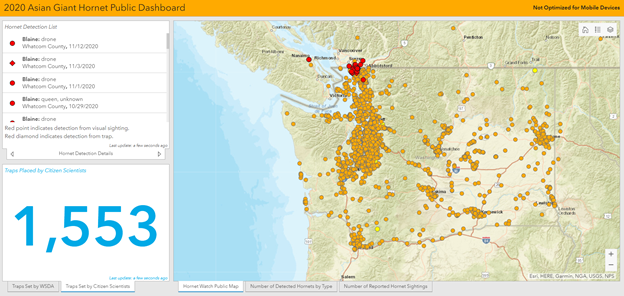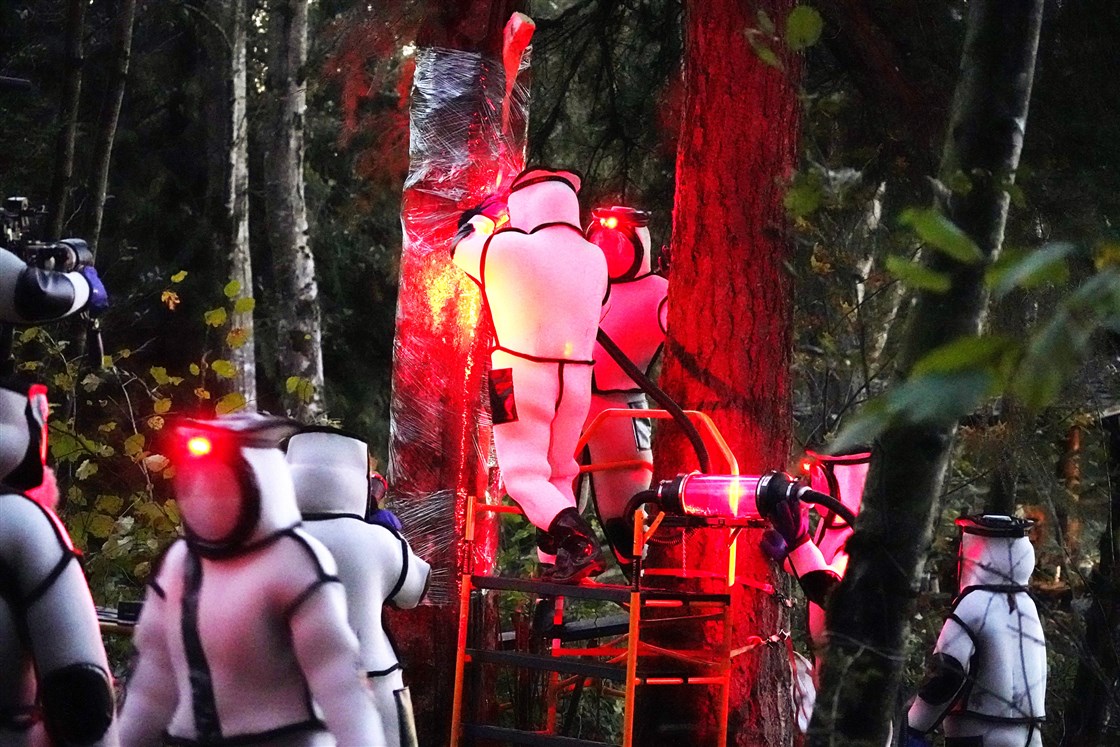
The Washington State Department of Agriculture created an Asian Giant Hornet Public Dashboard to share detection and trapping data.
WGA's Invasive Species Data Mobilization Campaign encourages land managers, citizen scientists, and others to standardize and share their invasive species occurrence data. The response to invasive species outbreaks can be more effective, for example, by timely sharing of information about invasive species’ locations. Over the past year, for example, the State of Washington and "citizen scientists" have collaborated to rapidly respond to the Asian giant hornet.
The Asian giant hornet (Vespa mandarinia) is the world’s largest species of hornet. In December 2019, the Washington State Department of Agriculture (WSDA) confirmed the first two reports of the hornets, often called "Murder Hornets," in the United States. If this pest becomes established, it will pose a threat to human health, honeybees and agriculture.
WSDA, as part of its response, determined it would be crucial to involve the public to help detect populations of the Asian giant hornet to expose the extent of its spread. In turn, citizens generated thousands of reports, resulting in 15 confirmed detections in 2020.
Washingtonians were also invited to participate in a citizen scientist Asian giant hornet bottle trapping program in 2020 that ran from July to October. Participation required a commitment of time and resources that included registering traps to WSDA’s online mapping system and checking, replacing and submitting weekly trap contents. Registering traps required citizens to provide the location of their trap, after which they were provided with a unique trap number that accompanied submission of their weekly collections. WSDA is still processing collection data, which it plans to share when available along with a web map on which citizens can navigate to their trap and find a summary of what was found there.
 The citizen scientist program also aided by trapping in locations outside WSDA’s response grids. "Cooperators" were also tapped to trap at areas of interest where citizen scientists had less access. Citizen scientists registered 1,227 bottle traps and cooperators placed 325 bottle traps. The traps ultimately were successful in capturing two Asian giant hornets, and citizen participation led, in October 2020, to the first successful Asian giant hornet nest eradication in the U.S.
The citizen scientist program also aided by trapping in locations outside WSDA’s response grids. "Cooperators" were also tapped to trap at areas of interest where citizen scientists had less access. Citizen scientists registered 1,227 bottle traps and cooperators placed 325 bottle traps. The traps ultimately were successful in capturing two Asian giant hornets, and citizen participation led, in October 2020, to the first successful Asian giant hornet nest eradication in the U.S.
WSDA created a 2020 Asian Giant Hornet Public Dashboard to share detection and trapping data. Citizen scientists were able to view detections in real time, including the number of reported sightings and number of hornets confirmed by type. There is also a section showing how many traps were placed and WSDA set up a shared group within ESRI's ArcGIS Online cloud-based mapping platform. Survey data was also provided to the U.S. Department of Agriculture (USDA) through shared feature services. This process provided USDA with instant access to data for analysis that obviated the need for WSDA to provide weekly, monthly, or on-demand updates.
Coordinating this information provided input on future trapping and demonstrated the benefit of collaboration with citizen scientists. WSDA has indicated that citizen data sharing and bottle trapping efforts are crucial to protect Washington from this invasive species.
This article is part of a series in the WGA Invasive Species Data Mobilization Campaign. Learn more at the campaign webpage. A big thanks to WSDA for its collaboration in this effort.
Get the latest news about the West and its governors by following the Western Governors' Association on Twitter, Facebook and LinkedIn.
Check out our podcast, Out West, on Podbean, Spotify and Apple Podcasts.